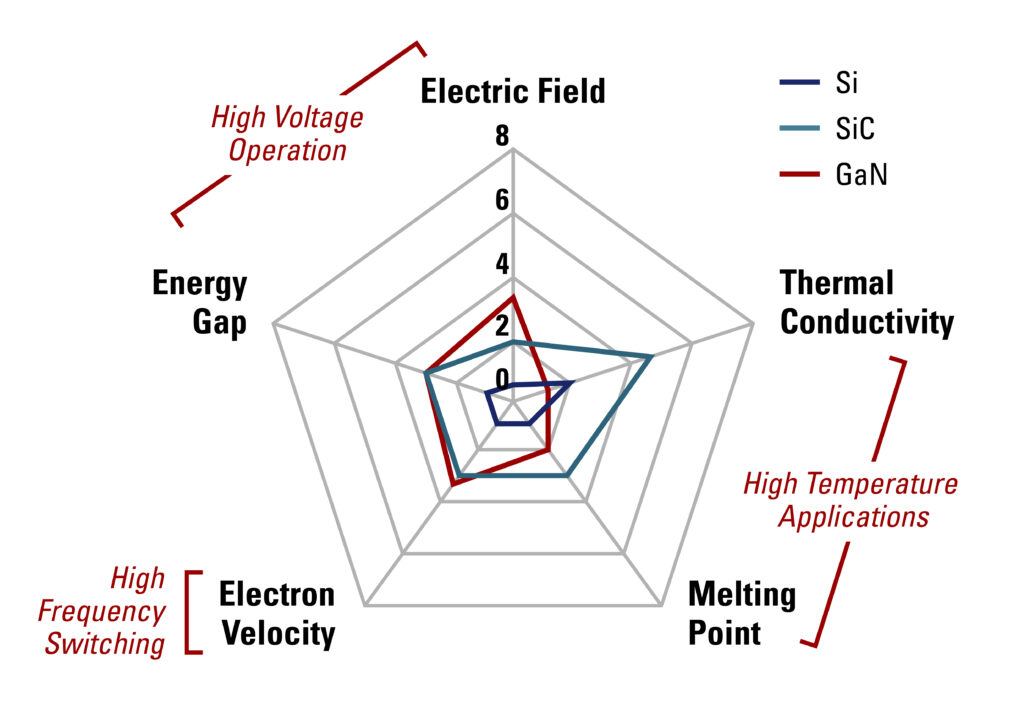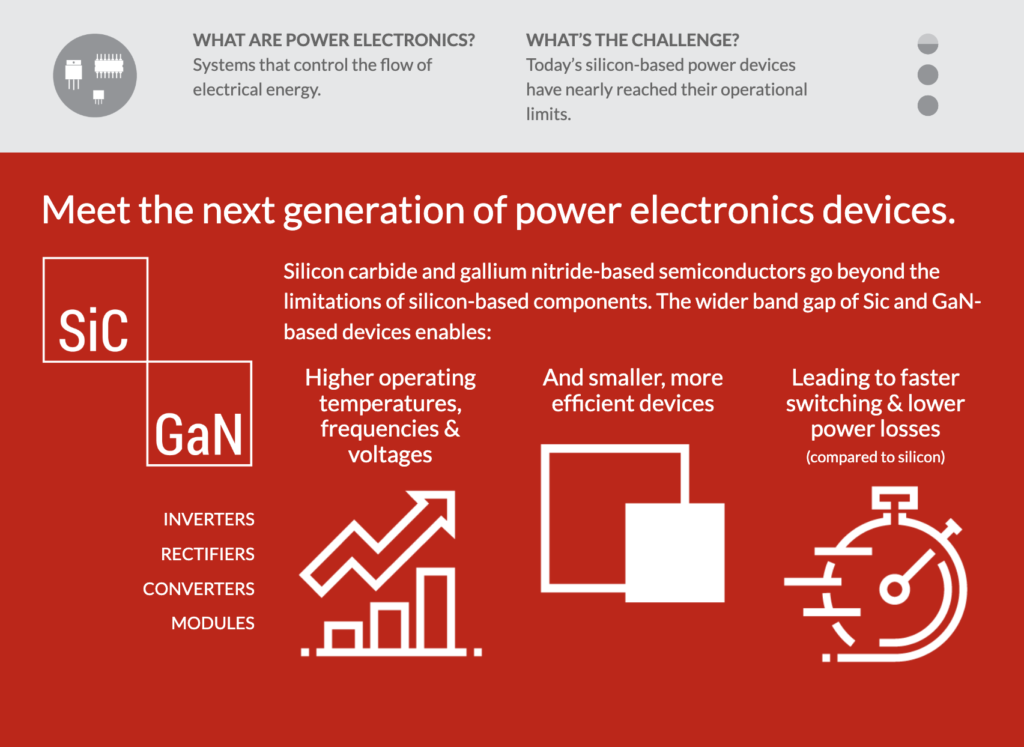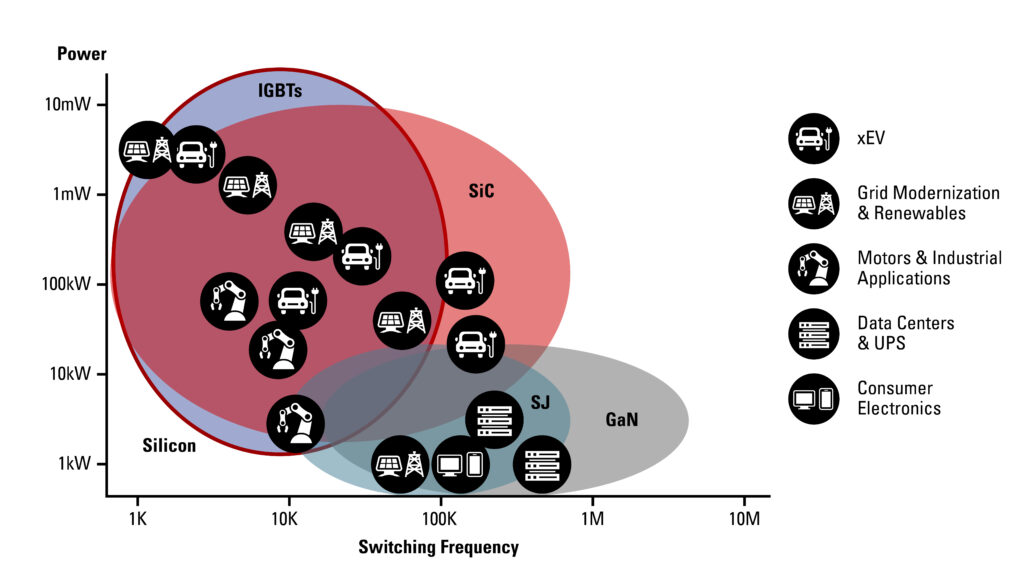Why Wide Bandgap
Wide bandgap semiconductors can operate at much higher temperatures, voltages and frequencies — making electronics more powerful and energy-efficient than conventional materials allow.
Wide bandgap (WBG) semiconductors — the same materials used in LED light fixtures and many flatscreen TVs — will make the next generation of power electronics more efficient, affordable and compact.
Harnessing the capabilities of WBG semiconductors can lead to dramatic energy savings for companies and consumers alike; allow electric vehicles to drive farther and longer; and help integrate renewable energy into the electric grid.
Comparison of Relevant Semiconductor Properties
The graphic below compares the material properties of SiC and GaN and shows how they create new opportunities to develop electric power systems that are superior in important ways.

The Benefits Explained

Silicon carbide (SiC) and gallium nitride (GaN) — today’s two major WBG material semiconductor platforms — improve the performance of power electronics systems beyond the limits of traditional silicon-based designs.
How Wide Bandgap (WBG) Technology Benefits Everyone
From the smartphone in your pocket to the chips and batteries in the newest electric vehicles on the market today, you can find WBG technology making an impact.
Silicon carbide (SiC) has become popular in the automotive industry and is also commonly used in solar panels and data centers. Meanwhile, you can thank Gallium nitride (GaN) for the ability to charge your smart devices faster; from 2019 to 2024, GaN helped fast chargers increase from 50 to 240 watts.
SiC and GaN are both used in semiconductor chips — which perform critical power conditioning functions in devices like rectifiers (which convert AC electricity to DC), inverters (which convert DC electricity to AC) and variable-frequency drives (which include both inverters and rectifiers.
Using WBG-based power electronics in consumer electronics and data centers alone could save enough electricity annually to power over 1.3 million homes.
Semiconductor Application Space
The graphic below shows the many industrial and consumer applications where SiC and GaN are being introduced. The energy, operational and performance advantages of SiC and GaN are critical enablers of the “electrification of everything.”

Consumer Electronics
Laptops, smartphones, and tablets account for a solid chunk of electricity use today, and the demand for these products continues to rise. The small converter on the cord of your laptop computer, for example, converts the AC power from your wall outlet into the DC power used by your laptop.
Data Centers
With the breakneck pace at which data is being created, we need more of these facilities seemingly every day. And just like the converters needed to charge your laptop or phone, data centers need to convert power to meet the needs of the diverse components of modern data center systems. WBG chips could eliminate up to 90% of the energy losses in the rectifiers currently used to perform power conversion.
Industrial Systems
Industrial motor systems use well over half of the electricity consumed in U.S. manufacturing. Some motor systems use a variable-frequency drive (VFD) to dynamically adjust motor speed to match power requirements and save energy. WBG chips can make VFDs more efficient and compact — and will likely expand the range of motors in which VFDs are cost-effective.
Energy Savings
Chips perform critical power conditioning functions in devices like rectifiers, inverters and variable-frequency drives (which include both inverters and rectifiers). WBG chips perform these functions more efficiently, yielding significant energy savings.
Renewable Power
Energy generated by wind turbines and solar photovoltaic systems must be converted from DC to AC before it can reach the electric grid. WBG chips can provide the required conversion in the inverter. More efficient WBG-based power electronics for solar and wind-energy conversion could save enough electricity annually to power more than 700,000 homes.
Sectors Where WBG Makes the Most Impact
SiC and GaN semiconductors have applications across several sectors — both civilian and military.
Industrial
Precision variable-speed drives & high temperature operation
Education and Workforce
Educating the next generation of WBG workers
Electric Transportation
Efficient charging & increased range
Renewable Energy and Grid Modernization
Higher efficiencies in power conversion & a more secure energy grid
Defense
Smaller, faster, lighter, & more rugged power electronics
Data Centers and UPS
Reduced power and cooling requirements
Heard enough?
See why you should join PowerAmerica.
